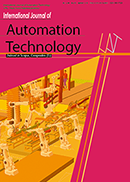Volume 16, Issue 3
Displaying 1-14 of 14 articles from this issue
- |<
- <
- 1
- >
- >|
Special Issue on Smart Factory
-
Article type: Editorial
2022Volume 16Issue 3 Pages 249
Published: May 05, 2022
Released on J-STAGE: May 05, 2022
Download PDF (36K) -
Article type: Paper
2022Volume 16Issue 3 Pages 250-260
Published: May 05, 2022
Released on J-STAGE: May 05, 2022
Download PDF (624K) -
Article type: Paper
2022Volume 16Issue 3 Pages 261-268
Published: May 05, 2022
Released on J-STAGE: May 05, 2022
Download PDF (429K) -
Article type: Paper
2022Volume 16Issue 3 Pages 269-279
Published: May 05, 2022
Released on J-STAGE: May 05, 2022
Download PDF (1264K) -
Article type: Technical Paper
2022Volume 16Issue 3 Pages 280-285
Published: May 05, 2022
Released on J-STAGE: May 05, 2022
Download PDF (289K) -
Article type: Technical Paper
2022Volume 16Issue 3 Pages 286-295
Published: May 05, 2022
Released on J-STAGE: May 05, 2022
Download PDF (357K) -
Article type: Paper
2022Volume 16Issue 3 Pages 296-308
Published: May 05, 2022
Released on J-STAGE: May 05, 2022
Download PDF (444K) -
Article type: Paper
2022Volume 16Issue 3 Pages 309-319
Published: May 05, 2022
Released on J-STAGE: May 05, 2022
Download PDF (417K) -
Article type: Paper
2022Volume 16Issue 3 Pages 320-328
Published: May 05, 2022
Released on J-STAGE: May 05, 2022
Download PDF (297K)
Regular Papers
-
Article type: Paper
2022Volume 16Issue 3 Pages 329-339
Published: May 05, 2022
Released on J-STAGE: May 05, 2022
Download PDF (689K) -
Article type: Paper
2022Volume 16Issue 3 Pages 340-348
Published: May 05, 2022
Released on J-STAGE: May 05, 2022
Download PDF (389K) -
Article type: Paper
2022Volume 16Issue 3 Pages 349-355
Published: May 05, 2022
Released on J-STAGE: May 05, 2022
Download PDF (517K) -
Article type: Paper
2022Volume 16Issue 3 Pages 356-366
Published: May 05, 2022
Released on J-STAGE: May 05, 2022
Download PDF (486K) -
Article type: Paper
2022Volume 16Issue 3 Pages 367-373
Published: May 05, 2022
Released on J-STAGE: May 05, 2022
Download PDF (819K)
- |<
- <
- 1
- >
- >|
